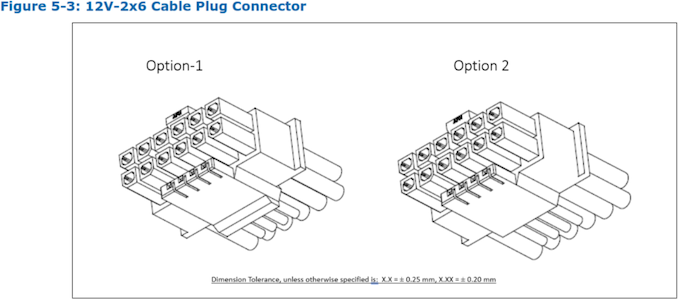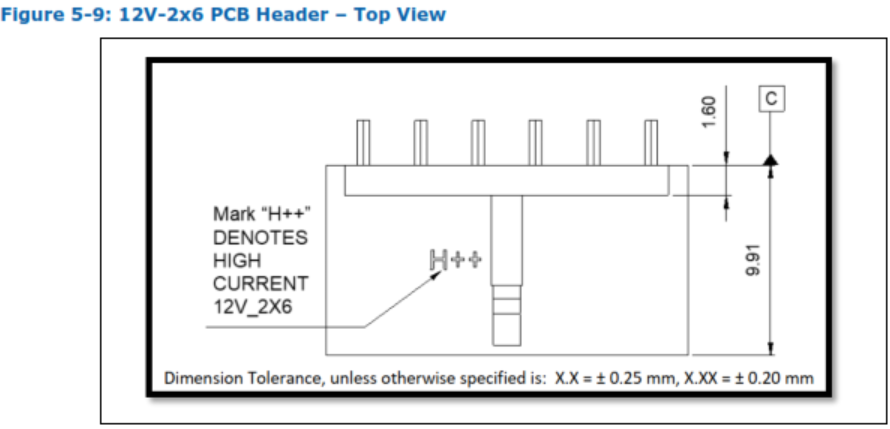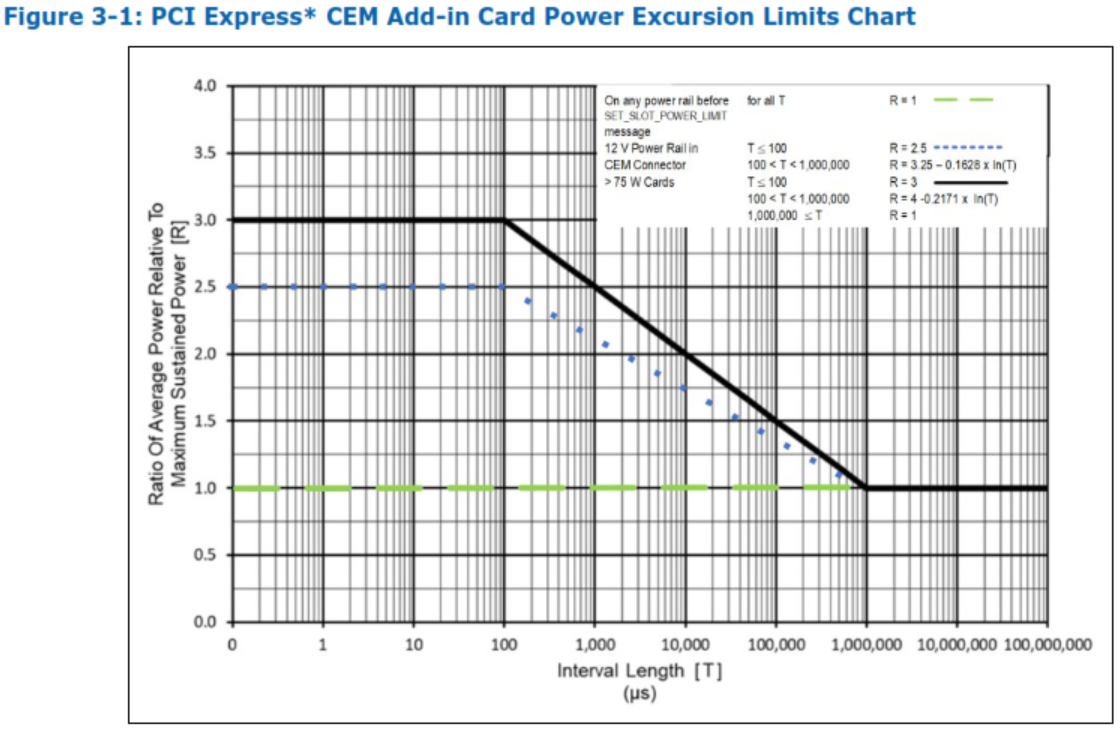The XPG Core Reactor II VE 850W PSU Review: Our First ATX 3.1 Power Supply
by E. Fylladitakis on May 2, 2024 10:00 AM EST- Posted in
- Cases/Cooling/PSUs
- PSUs
- 80Plus Gold
- XPG
- ATX v3.1
ATX 3.1: New 12V-2×6 Connector & PCIe Slot Power Excursions
The ATX v3.1 specification was officially launched on 13 September 2023, following the release of the ATX v3.0 in February 2022. The new specification includes the PCIe Card Electromechanical Specification Revision 5.1 (or PCI-SIG CEM 5.1) and complies with all previous Engineering Change Notices (ECNs) from PCI-SIG.
The primary purpose of the updated specification is to standardize that power supplies switch over from the 12VHPWR connector to the newer 12V-2×6 connector. Though there are a few other interesting changes as well, including some changes that lighten the burden of PSUs.
Nonetheless, the differences between Intel's ATX 3.1 and ATX 3.0 specifications are largely superficial, primarily involving minor updates rather than substantial changes. ATX 3.1 mostly introduces nuanced adjustments to power requirements and connector specifications, which do not radically alter the foundational architecture or the overall performance standards established by ATX 3.0.
The 12V-2×6 Connector: Shorter Sense Pins For Safer Power
The most prominent change in ATX v3.1 undoubtedly is the introduction of the 12V-2×6 connector, which is a backwards-compatible connector designed to supplant the quickly-obsoleted 12VHPWR connector. Improving upon the safety risks with the 12VHPWR connector, 12V-2×6 connector implements some mechanical upgrades and new settings for the sense pins, the combination of which is intended to avoid sending power down a poorly connected wire.
The v3.1 spec provides a detailed overview of the new 12V-2×6 connector through updated figures and sections. Key aspects, such as the power pins' current rating, connector body labeling, and pin contact material, are explicitly discussed.
Figures 5.3 to 5.9 of the ATX v3.1 specification are new and now exhibit the 12V-2×6 connector. According to the ATX v3.1 specification, the 12V-2×6's design permits potential support of up to 1324.8W per connector with a maximum temperature delta of 30 Celsius degrees above ambient. The use of copper alloy contacts and 16 AWG cables remains mandatory. Even the latch retention strength remains the same between the two specifications, at 45N for axial pull.
Units with 12V-2×6 connectors must have clear labeling on the connector body (H++). Units with 12VHPWR connectors shall have them labeled as H+.
The new specification also includes a whole paragraph of detailed recommendations for the cable plug connection that encompasses everything from recommending specific crimp contact types to the temperature resistance of the connector and low level contact resistance of the pins. These recommendations were not included in the previous specification, but that doesn't mean that 12VHPWR connectors do not comply with them, or for that matter that all 12V-2×6 connectors do. Even if it was a requirement instead of a recommendation, we suspect that low-quality products would not comply with those figures.
Broadly speaking, there are no physical differences between the bodies of the 12V-2×6 and 12VHPWR connectors, aside from a minor definition of a second plug housing option with a thumb-ridge design for the sideband signals shroud (Figure 5-3 of the ATX v3.1 specification).
Internally, however, there is a subtle, yet vital difference – the PCB Header’s internal pin lengths have been changed, making the power pins being longer and sense pins shorter. This design ensures a "first-mate/last-break" engagement, meaning the power pins connect before the sideband pins, and disconnect after. Such a sequence is pivotal for ensuring safety – and is something that was either overlooked or underestimated when defining the 12VHPWR connector.
Doubling-down on this shift to safety, how the sense pins are interpreted has also been changed. Now if both sense pins are unconnected (open), the ATX 3.1 standard dictates that devices are not to be supplied any power at all. The basis behind this change being that in scenarios where connectors might be incorrectly attached or completely absent, this configuration prevents a PSU from sending power down the line, effectively avoiding potential connector damage or melting.
Suffice it to say, that is a notable change over the previous specification, where two open sense pins was used to trigger 150W mode. Intended as a compatibility measure with 150W 8-pin PCIe power plugs, using open pins for 150W mode meant that PSUs lacked a good (and mandated) way to tell if there is a reliable connection between the PSU and video card. So this fixes that issue by making the null case to not send any power at all; the sense pins on the PSU side must sense something before the PSU will send down power. Which in the case of the newly displaced 150W mode, now requires the two sense pins to be shorted together.
The changes to the sense pins are a hardware-level change for PSUs, albeit a minor one. Whereas an ATX v3.0 compliant unit would permit up to 150 Watts if both sense pins are disconnected, an ATX v3.1 compliant PSU will not deliver any power at all. Fortunately, besides improving safety, this strategy is designed to be fully backwards compliant, so that 12VHPWR-equipped video cards will still work with the newer PSUs – and for that matter newer video cards with older PSUs as well (albeit without the additional safety of the zero-Watt mode).
As for the cables themselves, these remain unchanged and are fully compatible with the new connector. The only changes are on the device/host sides, and not the copper in the middle that is connecting the two.
Otherwise, 12V-2×6 is not in any way more capable than the 12VHPWR connector in terms of strength and/or power delivery capabilities.
Adding PCIe Slot Power Excursions, Updated Power Delivery Tables
While the chief importance of the ATX v3.1 specification is the introduction of the 12V-2×6 connector, the standard also makes some small, but notable, updates to the power tables that define power excursions for both cables and PCIe slots, and how they're to be handled.
In the v3.1 spec, it is specifically noted that power excursions are permitted from the 12V rail of the PCIe slot. Thus, the 12V rail on the PCIe slot can experience spikes up to 13.75A for up to 100μs (equivalent to 165W). Previously, the limit was a mere 5.5A. The 12V rail can be boosted for up to 1 second using a logarithmic formula included in the new ATX 3.1 specification (Table 3-1). No power excursions are permitted on the 3.3V rails.
Table 3-1 and Figure 3-1 of the specification have been updated to include the power excursion margins of the PCIe slot. We can see that the new figure now includes a blue line specifically for the allowed power excursion over time for the PCIe slot itself. The black line refers to the total power excursion allowed for each individual card (PCIe slot + 12V-2×6 connector).
One more interesting change lies with Tables 3-3 and 3-4 which dictate the testing criteria for power excursions, with Intel reducing all of the testing duty cycle times. Although the maximum excursion remains at 200% power over 100 μs for a card with a 12V-2×6 connector, the testing duty cycle has been halved. Oversimplifying this change, it means that the new specification allows for power excursions of the same magnitude but requires twice as much time between excursions.
This could be mistaken as far less strain for the PSU but that is not actually true, as the calculation formula increases the power during the remainder time, resulting to nearly identical RMS power over time. Intel just, for whatever reason, effectively halved the maximum time power excursions should last over the last version.
Intel has also updated Table 3-5 to specifically include all four power modes that the new 12V-2×6 connector can operate at. Previously, the ATX v3.0 specification only presented the 600W/55A option of the 12VHPWR connector.
Another change that is indirectly related to the above is the lower Voltage Hold Up times, which can be found in Table 4-8. The ATX v3.1 spec includes a “recommended” hold up time of 17 ms at 80% load next to the required 12 ms at 100% load. These figures are slacker than the previous ATX v3.0 specification, as there was only a required hold up time of 17 ms at 100% load. As relevant hardware (i.e. UPS systems) also improved their reaction times over the years, Intel probably decided that 17 ms is too strict for modern high-power PSUs, unnecessarily requiring them to include too bulky capacitors to even try and comply with the specification. The winners here are the very high output designs that would require very large (i.e., expensive) capacitors to comply and compact unit designers as they can now use smaller capacitors for their platforms.
Ultimately, power supply manufacturers will have very little difficulty adjusting their products to comply with the ATX 3.1 standard, and we suspect that most of the currently available platforms will merely undergo minor tweaking to comply with the zero-Watt mode. ATX 3.0 PSUs will continue being compatible with modern graphics cards, merely lacking the extra safety the 12V-6x6 connector can offer via its first-mate/last-break design. If anything, the brute of the changes will be hitting motherboard designers, as future motherboards needs to comply with the PCIe slot power dynamics. It's too early to predict what this will mean for future graphics card compatibility, but the addition of 12V power excursions over PCIe slots is not a trite change overall.


















31 Comments
View All Comments
Reflex - Friday, May 3, 2024 - link
Tesla announces a lot of unverifiable things. No point in doing their PR for them. Replyzodiacfml - Saturday, May 4, 2024 - link
true but they can revolutionize efficiency in datacenters as they have existing solar and battery products and services. it's just a matter of scale which is likely the cause of delays, like they can't simply ask Nvidia to make 48 volt power AI graphics cards-unless Tesla buys so much or convince other tech giants to go 48V ReplyTheinsanegamerN - Monday, May 6, 2024 - link
That would require sweeping industry wide changes and break decades of compatibility. Fat chance that happens. Replyballsystemlord - Thursday, May 2, 2024 - link
@Ryan , the "hot box testing" section has 2 images of the conversion losses and 0 images of the fan curve. Please fix this. Thanks! ReplyRyan Smith - Friday, May 3, 2024 - link
D'oh! Thank you for catching that.Unfortunately that's a problem with the image itself (right image, wrong data), and needs to be regenerated by hand. So I'm not able to immediately fix it. I'll have Tracy upload the correct one as soon as possible. Reply
Ryan Smith - Saturday, May 4, 2024 - link
And fixed. Replywr3zzz - Thursday, May 2, 2024 - link
What's the safest way to use previous gen 1000W PSU for RTX4090/5090? ReplyrUmX - Friday, May 3, 2024 - link
For 5090, we don't know. That GPU didn't release yet. ReplyRyan Smith - Friday, May 3, 2024 - link
Make sure the cable you're using is making very good and tight connections at both ends.If there is a problem, it's much more likely to occur on the video card end of things, and those are already by and large using the new 12V-2×6 connector since it's such a quick swap. Reply
shabby - Friday, May 3, 2024 - link
Keep a fire extinguisher close by... Reply